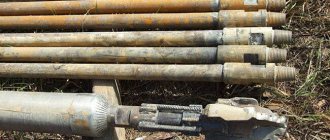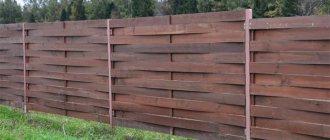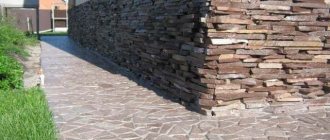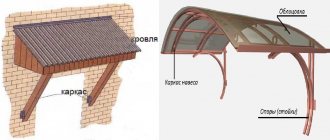Collection, purification and disposal of wastewater from the site is one of the most important tasks for ensuring comfortable living in a private country house. This article will describe the step-by-step process of constructing a sewer system from concrete rings with your own hands.
One of the most popular materials for solving this issue is concrete rings.
Devices made from such elements for a private home are the most durable, require virtually no repairs during operation, are financially affordable for any budget and are easy to install.
External waste disposal system
Sewer rings are the main component of its outer part, performing the functions of containers for various purposes in a wastewater treatment system. Products used are walk-through, without a bottom and equipped with bottoms. In addition, covers in the form of concrete slabs with a passage opening for maintenance are a mandatory element. For filter wells, rings with perforated walls are also used, in which a bottom filter is installed.
The finished container is equipped with two lids - an inner wooden one and an outer plastic or cast iron one. Concrete sewerage products are immersed in the ground to a depth that ensures that only the top cover protrudes outward.
The advantages of using such products include the following properties:
- strength, allowing you not to fear damage when the soil freezes in winter;
- durability - high-quality products of standard quality can serve in the sewerage system for up to 50 years;
- ease of installation - do-it-yourself reinforced concrete sewerage is quite affordable for most performers;
- cost savings on purchasing rings compared to ready-made plastic containers.
The main disadvantage of concrete sewer systems is the large volume of excavation work, but this property is equally inherent in any external drainage and wastewater treatment systems.
Construction of a filter well from sewer rings
Such a well is necessary to filter wastewater and sewage entering the septic tank through the pipeline.
Solid fractions settle at the bottom, and the water is redirected to the drainage well, from which it flows into the soil. You need to dig a ditch under the filter well until a layer of sand is reached. If this is not possible, then you should arrange a drainage field, which you can do yourself. Construct a drainage well in a certain sequence:
- First of all, pour a cushion of sand 50 centimeters thick and compact it thoroughly.
- Gravel 20 cm thick is placed on the sand.
- Before digging in rings for sewerage, drainage holes are drilled in the first of them, which have a diameter of 30-50 millimeters. They are made at a distance of 50 centimeters from each other in a checkerboard pattern.
- A ring with holes is lowered into the hole using special equipment.
- Next, the installation of sewer rings that still remain is performed. They are connected to each other.
- A layer of gravel is poured from the outside of the well up to the height of the outermost drainage hole.
- The rings are connected to the septic tank.
- The well is covered with a concrete cover and the structure is filled with previously dug soil.
When arranging a filter well, you need to take into account that the distance between its bottom and groundwater should not exceed one meter.
How to calculate the volume of a container
For a more accurate calculation, we suggest using an online calculator.
In an effort to organize the most comfortable living conditions in a country house, the owners organize all the conditions inherent in urban conditions, including sewerage. In most cases, small suburban settlements are deprived of the opportunity to use centralized sewer networks due to their absence.
Therefore, each owner sets up local treatment facilities (LTP), designed not only to remove wastewater, but also to treat it to an accessible extent, ensuring safe living not only for his family, but for neighbors living nearby.
Watch the video
Do-it-yourself septic tank made of concrete rings. Sewage in the house
This event is quite expensive, and the larger the volume of wastewater that needs to be processed, the greater the cost of its construction. For this reason, calculating the required power when installing a sewer system with your own hands from concrete rings is a pressing task.
The most popular design solutions for a local sewer system are concrete rings or solid plastic containers. They are installed sequentially and consist of 2-4 sections that perform different tasks. The connection between them is made by pipes.
Functionally they operate as follows:
- The first container is called a storage tank and is designed to separate the mass of wastewater from solid and heavier components. They settle to the bottom of the vessel and are removed as they accumulate.
- The second tank is intended for biological treatment of wastewater. For this purpose, special cultures of bacteria are used, which are introduced into the vessel as needed. A sediment called activated sludge forms at its bottom, in which the bacterial composition is renewed. As necessary, this composition is pumped out, and a certain part of the mass is left for further use.
- In the third section, the wastewater is aerated by passing atomized air through it using a low-power compressor. Here the oxidation of wastewater occurs. Air also acts as a catalyst for the biological activity of the bacterial component.
- Further cleaning takes place in the filter well. To make it, concrete rings with perforated walls are used - in the lower part and an upper solid ring, covered with a concrete lid with an opening for passage inside.
A properly organized wastewater treatment system provides a degree of wastewater purification of up to 98%. This water can be safely used for watering the garden, washing cars and other household needs. Activated sludge is a very effective fertilizer.
The basic basis for calculating the volume of a sump is the average consumption value for one person, which is 200 liters of water per day.
Watch the video
DIY septic tank made from concrete rings from A to Z in one video
When calculating, this norm must be multiplied by the number of residents.
Table of container volume for a country house
| Number of residents | 2 – 3 | 3 – 4 | 5- 7 | 8- 9 |
| Useful volumes | 1,8 | 2,4 | 4 | 5,4 |
The table above is applicable for two or three chamber septic tanks.
It should be noted that for the first sections of the sewerage, concrete rings with a bottom are used to prevent untreated wastewater from entering the ground.
The data in the table is indicative only. The actual water consumption, and, consequently, the volume depends on the composition of the equipment used in everyday life. The presence of a sauna, jacuzzi, washing machine and dishwasher in the house significantly increases water consumption.
An example of calculating consumption volume
Let's assume that 4 people permanently live in the house. Then the approximate calculation of consumption volume will look like this:
- We determine the total liquid consumption per day - 4 x 0.2 = 0.8 cubic meters.
- Taking into account the standard for the minimum stay of wastewater in the settling tank for at least 3 days, we obtain the size of its capacity - 0.8 x 3 = 2.4 cubic meters.
- If you plan to use standard “15-9” rings, the internal diameter of which is 1.0 meters and the height is 0.7, we obtain the volume of the contents of one section 1.64 m. Thus, the total two-chamber capacity will be 3.28 cubic meters.
It should be taken into account that in reality the volume is somewhat lower, since the height should not be taken based on the size of the ring, but on the distance between the bottom and the edge of the overflow hole. But this will only be determined when drawing up an external sewerage project, and then the calculation will need to be checked based on actual dimensions.
Watch the video
The data obtained indicate that there is a certain reserve of external sewage capacity, but it will come in handy if you have to receive guests.
Rules for installing a concrete septic tank
According to building codes and regulations, a cesspool cannot be located too close to a residential property, local communications, highways and local roads, or green spaces. There are a number of requirements that must be taken into account so that you do not have to redo the work after a few years. Improper installation can cause an unpleasant odor in the area, a fine, and even huge financial losses as a result of the destruction of some structures. Let's look at the basic requirements.
- The septic tank is installed no closer than 6 meters from local asphalt and dirt roads and no closer than 10 meters to highways. The practical value of this law is low, but it must be observed, otherwise, during an expert assessment, you can receive a substantial fine and requirements to move this structure.
- No closer than 50 meters from drinking water on the site. If you have a well or stream in your yard, then you need to dig a hole on the other side of it. This is your safety first and foremost. Effluent can get into drinking water, causing contamination and, as a result, poisoning.
- Place it no closer than 25 meters from the reservoir (if there is one, of course), this applies to rivers, ponds, and lakes. Swimming pools are also included in this list.
- For the safety of green spaces, the cesspool is placed no closer than 3-4 meters to large trees. Fruit trees are planted no closer than 10 meters, as the root system can absorb hazardous substances. Eating such fruits is dangerous for your health.
These are the basic environmental requirements regarding the placement of a septic tank on the site. There are also construction nuances that determine the location of this building near the foundation structures, and the standards for installing sewerage systems. Let's take a closer look.
- Install the septic tank no closer than 6 meters from the foundation of the house (to avoid subsidence).
- 20 or more meters from the well.
- It cannot be constructed in low-lying areas, since melt water can overwhelm it. It is better to use higher ground for such purposes (groundwater is also a problem).
- The slope of the pipes is at least 2% per 1 meter.
- Bends are not allowed, especially turns over 50 degrees.
We reviewed all SNiP and environmental standards. If the place you have chosen does not correspond to any point, it is better to immediately reconsider the yard plan, so as not to carry out large-scale reconstructions later.
Sewage device diagrams
The basic principle of manufacturing a wastewater tank from this material is to maintain a slope along the placement of individual sections. The slope is created by connecting intermediate elements - pipes; its value should be within 1-3 millimeters per meter of system length.
With a lower slope, solid components of the drain may be delayed. The same effect is observed with a greater slope - water drains faster than contaminants move. This creates a blockage in the pipe that needs to be removed using special means.
An important design element is the junction of the overflow pipes with the body of the concrete rings. It must be carefully sealed with cement mortar, preventing leakage. Otherwise, the sewerage system will not perform its functions.
The above diagram of a wastewater treatment device shows all the main design elements, the purpose of which will be described below.
We install reinforced concrete rings for sewerage
Now we move on to the most difficult process in the construction of a cesspool - digging and immersing rings. Let's look at step-by-step instructions on how to do this.
Step 1
We take a bayonet shovel (a file will also come in handy) and set off to look for the treasure.
You already have its location on the site map, all that remains is to dig a hole there with a diameter of 180 centimeters. We try to make the walls as even as possible, at 90 degrees.
Step 2
We roll the rings to the hole.
They can be very heavy; use metal pipes and a wooden beam for edging. It's best to take a partner with you. The ring can be tied with a cable and smoothly lowered to the bottom of the formed well. It will not break, even if lowered without a cable, since the hole fits exactly in diameter, and the concrete will simply slide smoothly along the walls. You only need to hold it to avoid distortions.
Step 3
We increase tightness.
Between the rings (there will be 3 of them), all seams must be properly sealed so that water does not pass between them. Cement 1:2 with sand and just cover the joint.
Step 4
.
We make another exactly the same hole and lower 3 rings into it. It should be placed every 1.5 meters.
Step 5
.
We punch a hole between the holes with a diameter of 15 centimeters (concrete rings should also be punched), insert a pipe of a suitable diameter into it, preferably asbestos. We cement everything around the pipe so that there are no gaps. You can make a screed at the bottom of the septic tank if you pump it out.
Now the pit is completely ready. All that remains is to install a sewer system and arrange the top (close the septic tank). You will get about 7-8 cubic meters of usable area. The sewer system is designed for permanent residence of 5-6 people in a private house with a bathhouse and other conditions.
Types of containers and features of their designs
Subject to the standard design of the device, design solutions may be different.
First of all, you need to understand that a septic tank is a source of increased danger to the environment and the uncontrolled construction of such facilities is prohibited. Before starting work, it is necessary to develop a project, approve it with the SES and only after that begin its construction. Permission can be obtained in full compliance with the requirements of San Pin and SNiP.
General rules for wastewater treatment facilities are as follows:
- The main document regulating the placement of sewage tanks in suburban areas is SNiP number 2.0403-85. It details the requirements for the location of the sewerage facility in relation to various buildings.
- If there are water supply facilities on the territory, the rules of relative location are provided for by SNiP 2.0401-85.
- Many distances according to the standards are provided for by the requirements of San Pin 2.1.5580-00.
- San Pin 2.2.1/2.1.1-12-03 establishes the rules for water protection zones of water supply facilities.
It should be taken into account that there are overlaps in the mass of regulatory documents. So in one of them the minimum distance from a shambo to a residential building is set at 10 meters, in others - 5. To avoid difficulties when approving a sewerage project, it is better to adhere to a larger norm.
Watch the video
➁SEPTIC TANK made from concrete rings WITH YOUR OWN HANDS ⓉⓊⓉⓈⓉⓇⓞⓘⓚⒶ
The design of a local treatment plant depends on many factors, ranging from the size and nature of the landscape to the qualitative composition of the soil. Therefore, there are several types of settling tanks.
Single chamber drives
It should be immediately noted that these structures are currently prohibited, although a considerable number of them still continue to be used. Let's remember the norms of water consumption - 200 liters per person. Even with two people living, this amounts to 0.4 cubic meters per day; even a five cubic meter storage tank is filled in at least two weeks.
5 cubic meters is the volume of a standard tank. That is, pumping must be done every 2 weeks, paying up to 12,000 rubles each time (for the Moscow region). Really? No! Therefore, most of the wastewater is poured onto the road, the garden, or anywhere. Only waste products go into the storage tank. And then we drink water from the well.
A sewer pit made of concrete rings slightly increases the period between pumpings, but calling such a structure a treatment device can only be a very stretch.
Double chamber
A sewer system made of concrete rings, consisting of two containers, provides greater opportunities for wastewater treatment. This happens for the following reasons:
- There is an additional opportunity for sedimentation of solid components of wastewater, settling to the bottom of the second vessel.
- In the second container, it is possible to treat with biologically active components that actively process contaminants in wastewater. For this purpose, cultures of anaerobic bacteria are used, which decompose the components of the drain and neutralize them. As a result, a dense bottom sediment is formed, which is called activated sludge. It is a habitat for bacteria, the content of which constantly increases, increasing the degree of purification. As it accumulates, it is necessary to periodically clean the tank with pumping out activated sludge, part of which is used to replenish the bacterial population.
Since we are talking about live cultures, chlorine is not allowed to enter the wastewater as it passes through the chamber. In this case, the death of the colony of beneficial bacteria is inevitable. If you want to carry out additional disinfection of purified water, it can be treated with bleach before discharging it onto the ground.
With this design of a two-chamber storage tank, concrete rings with a bottom for the first storage section are used as a container. The second section is installed in the form of a filter well.
It is a device of two rings installed on top of each other. In this case, the lower ring is used with perforation.
Let us pay attention to the design of the filter well. Its maximum depth is no more than 2.5 meters. Wherein:
- A gravel cushion 30 centimeters thick is formed at the bottom of the pit. The material used is a fraction of 5-15 millimeters.
- Before installation, the outer surface of the rings must be treated with a waterproofing material, for which bitumen mastic is most often used.
- The lower ring is installed on a gravel bed and wrapped in geotextile up to the perforation level.
- A bottom filter is formed using fine gravel or blast furnace slag, which has increased absorption. The layer thickness is 15-25 centimeters. On top of it you can fill the broken brick with the same layer.
- The same gravel is poured outside the ring to the perforation level.
- A second ring and a floor slab of the appropriate size, equipped with a passage hole, are installed. It is necessary to make a wooden lid for it.
- The top floor slab and neck are installed in a standard version with a metal or plastic cover.
- To avoid wastewater leaks around the formed well, you need to install a clay seal, proceeding as follows:
- the clay intended for it is poured into a cone and a funnel is made on top into which water is poured;
- soaking of the material is carried out within 6 days;
- the clay must be stirred to the consistency of sour cream, adding reinforcing shavings to the solution;
- Fill the funnel around the well with the resulting solution;
- Dry the resulting clay seal for about a month, periodically sprinkling it with water.
The hole for the overflow pipe from the first tank is punched before pouring the water seal, the joint is sealed with cement mortar and treated with bitumen mastic.
Watch the video
Three chamber devices
The difference between such sewerage devices made of concrete rings is the use of an additional container in which additional wastewater treatment occurs through aeration using a low-power compressor and an air spray.
Aeration of liquids is carried out in order to use another type of bacteria for their purification - anaerobic bacteria, which actively act in the presence of oxygen in the air. With their use, the degree of purification is increased to 98-99%.
This water cannot be drunk or used for cooking, but it can already be used for technical purposes - washing a car and even watering a garden. When passing through the ground, the water undergoes final filtration.
The water that has passed through the settling tank is disposed of in various ways:
- discharge into a sewer (drainage) ditch;
- discharge directly onto the ground;
- diversion to the nearest body of water.
Advantages of concrete rings
If we talk about the significant advantages of concrete rings, it is necessary to emphasize the following features of the products:
- Installation of structures made from such materials does not take much time;
- Concrete rings are relatively cheap;
- During installation, it is possible to ensure the tightness of the joints without any special difficulties;
- The main distinguishing feature of such a septic tank is its relatively high strength;
- The service life of these products is about 10 years.
Some rings are manufactured with special hygienic requirements. They can be used to equip wells. High-quality concrete mixture provides high strength characteristics. For this purpose, a special reinforcing wire mesh is used in production, which is placed in a mold for a concrete ring before the solution hardens. Some manufacturers do not pay enough attention to the strength of the concrete rings they produce. Therefore, when choosing, it is advisable to pay special attention to this issue so as not to purchase a product of insufficient quality.
Reasons why experts recommend choosing concrete rings as materials for septic tank equipment:
- The useful volumes of the septic tank can be increased without much difficulty by installing additional rings.
- Reinforced concrete is considered the material that is most resistant to the environment and substances that make up sewage.
- The service life of large rings is considered relatively high.
- Concrete chambers will always remain in place. Owners of summer cottages do not need to worry that the septic tank will float up as a result of rising groundwater levels or flooding.
- The installation technology is not complicated. The relatively large weight of concrete rings is not a problem if heavy lifting equipment is used during the installation process.
Any homeowner can purchase concrete rings that are sized and shaped to suit their needs. The hardness of the concrete must be sufficient for the use of rings when equipping sewer septic tanks. If the seller has a certificate confirming the quality of the products manufactured, you can choose the appropriate rings for your drainage system.
Pit preparation
Installation of sewerage from concrete rings involves performing a large amount of excavation work. But before you start, you need to make sure the feasibility of such an event. To do this you need:
- Carry out exploratory drilling to determine the nature of the soil at the site of the proposed installation of the sump. If the subsoil is clay, it is better to completely abandon the idea of complete wastewater treatment, since it practically does not allow water to pass through, which does not allow the filtering capabilities of the soil to be used.
- Find out the depth of subsoil aquifers and the level of seasonal fluctuations in liquid in them.
Digging a pit can be done in three ways:
- using earth-moving equipment - an excavator, which requires free access and space for maneuvering. In this way, a pit can be dug in an hour. In addition, the problem of removing excavated soil is being solved;
- a team of hired workers can resolve the issue during the working day;
- independently - in this option, digging a pit can be completed in 7-10 days, depending on the amount of work.
Experience shows that the cheapest and highest quality option is to use technology.
Watch the video
Septic tank with overflow made of concrete rings
Instructions for building a cesspool
The installation of each specific tank has its own nuances related to the characteristics of the landscape, soil, location of the sewer network, etc. We will look at a typical diagram for constructing a cesspool.
Stage #1 - excavation development
The first stage is earthworks. They can be done alone (long, hard and free) or with the help of a team (fast and fun, but for money).
If possible, you can use a mini-excavator, then workers will only be needed to “grind” the walls and level the bottom of the pit.
The shape and dimensions of the pit must correspond to the configuration and dimensions of the tank. Accordingly, the result should be a round well, the width exceeding the concrete rings by 0.3-0.5 m on each side around the circumference.
This gap will be required for sealing/insulating the structure from the outside and subsequent backfilling with compaction.
A pit for a sealed cesspool consisting of 2 concrete rings. The depth of the sewer pipe is about 0.8 m, the finished height of the tank is 2.5 m
There is one nuance that should not be forgotten - this is the level of soil freezing (the information is relevant for residents of central and northern Russia).
The sewer pipe for waste and the main part of the tank must be below this level for the system to function in winter. If you lay the network near the surface, when frost sets in, the liquid will simply freeze.
In this regard, to the dimensions of the working container it is necessary to add the height of the neck, which essentially serves as a technical hole. The neck should protrude 15-20 cm above ground level.
Thus, the tank will be buried, as will the sewer pipe cut into it below the freezing level.
Before the start of construction work, it is necessary to level the base with the walls and dig a ditch leading from the house (bathhouse, summer kitchen, garage) to the drainage pit.
When constructing a ditch, do not forget that in order to avoid blockages, the pipe must have a slope towards the pit - approximately 2 cm per meter.
Stage #2 - arrangement of the bottom
If you are installing an ordinary storage container, the bottom, like the walls, must be sealed. For a structure made of concrete rings, the best option is to make a blank from the same material.
The part is specially designed to decorate the bottom of the well and has a groove around its circumference. The only thing needed for its installation is a flat, dense base.
Reinforced concrete element equipped with a bottom. Designed for the construction of sealed cesspools, serves as an alternative to a concrete slab or cement screed
Possible subsidence of the base is eliminated by pouring a cement screed. It is prepared according to a simple scheme: for every part of cement - 4 parts of sand. For strength, you can add fine crushed stone in a ratio of 1:6.
The mass is prepared in a container, then poured over the entire area of the bottom of the pit and leveled. Within a week, the concrete screed is lightly irrigated with water so that it does not become covered with cracks. The lower element of the structure is installed no earlier than a week later.
For those who value time, there is a more practical solution - a pre-fabricated concrete slab. It is placed on a flat bottom, and the first concrete ring is placed on it.
The filter well does not have a bottom as such. Instead, a “cushion” is prepared - a filter made of building materials that retains solid sediment and allows liquid to pass into the ground.
Colonies of anaerobes, bacteria involved in the process of decomposition and purification of waste, settle on the backfill of crushed stone or gravel.
The thickness of the underlying backfill varies:
- shallow pits - from 0.3 m;
- tanks of 3-4 rings - up to 0.6-0.7 m.
The thickness of the filter bed placed in the well shaft must be at least 1.0 m.
The arrangement of layers is as follows:
- bottom layer – sand;
- middle layer – fine crushed stone;
- the top layer is coarse crushed stone.
Unlike a concrete tank, the “cushion” and filter are replaceable elements. When they become clogged with solid waste and stop allowing liquid to pass through, the old backfill is taken out and a new one is placed at the bottom of the hole.
Stage #3 - installation of concrete rings
The first ring, equipped with a bottom, is installed directly on the concrete slab (or screed). Smooth installation of the part guarantees a strictly vertical position of the entire structure, without tilting or distortion. Place a second one on the bottom element and immediately seal the seam.
To seal and waterproof seams, various solutions, coatings and roll materials are used. Using roofing felt glued to a bitumen mortar, joints and cracks are closed from the outside; it is not suitable for interior work.
Ordinary cement mortar is also considered weak: when the soil moves, it becomes brittle, causing it to crack and crumble.
There are many modern modified mastics and solutions that have sufficient strength and elasticity. Some of them can be applied to wet joints or seams that are already under water pressure.
Various methods of waterproofing a concrete septic tank are used to protect the walls from the destructive effects of an aggressive chemical environment, which is often contained in sewage.
Waterproofing the finished structure from the outside with bitumen mastic. Carried out to protect reinforced concrete from moisture in the soil and increase the degree of tightness
Here are some of the effective means for sealing joints and internal sealing:
- Hydroseals , which expand when hardening, tightly closing any cracks. Examples: Waterplug, Peneplug, Hydrostop. Their only disadvantage is their high cost.
- Solutions for application to the entire surface: Antihydron, Hydrotex, Bastion.
- Materials for caulking deep seams impregnated with Kiilto FIBERPOOL fiber rubber - cords and ropes made of jute, flax, hemp.
- Rubber sealing tapes , for example RubberElast.
- Liquid glass added to cement mortar
- Water-based sealants: Peneplag, Penetron, Penecrit.
High-quality waterproofing ensures structural integrity for up to 35 years.
After making sure that the connection between the rings does not allow water to pass through, you can install the next part.
Approximately 20 - 30 cm below the depth of seasonal soil freezing it is necessary to make an inlet for the sewer line. At the same stage, a pipe is laid and connected to the tank. The connection point is carefully sealed.
In the northern regions, pipes passing above the freezing depth are additionally insulated, as is the upper part of the storage tank.
If the pipeline is connected correctly, the outlet of the main should be above the average wastewater level. The top of the tank remains free
The neck is mounted on the 3rd or 4th ring, then the floor slab. The factory-made plate has a round hole for the hatch. Another hole, of a smaller diameter, is needed for the ventilation pipe.
The final touch is backfilling. If you add dry cement to the soil, the reliability of the structure will increase, and the risk of destruction by soil movements will decrease.
Stage #4 - design of the technical hole
The best option for exterior design is a sewer hatch with a tightly closing lid. Its inexpensive counterpart is simply a wooden lid attached to hinges.
The hatch is necessary for servicing the cesspool - pumping out waste or replacing the filter layer.
Plastic decorative cover for a manhole in the form of a large natural stone. Completely covers the entrance hole, looks quite natural against the background of surrounding greenery
Recently, it has become common to camouflage sewer structures, especially if they do not look aesthetically pleasing. For this purpose, decorative products are purchased that imitate green spaces or large stones.
But you don’t have to use purchased decor; you can assemble an elegant flower stand from wooden slats and decorate it with flowering plants.
Ventilation for sewerage
When processing wastewater, especially with a significant admixture of fecal waste, methane is released. In the absence of ventilation, its concentration can reach an explosive consistency.
In this case, ignition occurs when using electrical equipment from the slightest spark. The consequences can be fatal.
To avoid such consequences, you need to install ventilation in the well chamber.
Concrete rings as a base
Before the widespread use of concrete rings in the construction of septic tanks, car tires and oak boards were used to strengthen the walls. But more often the choice falls on concrete rings for sewerage due to the following reasons:
- affordable price;
- high assembly speed;
- high strength of the material;
- availability of all components for assembly;
- resistance of concrete to chemically active substances and corrosion.
The disadvantages are not so critical, but can increase the cost of the overall project. For example, transporting and installing concrete rings will require special equipment. And if the house is located far from the city, then it will cost a pretty penny. Water easily seeps through concrete due to its hygroscopicity. Thus, sewage can easily get into groundwater. To prevent such processes, it is necessary to take care of high-quality waterproofing of the mine.
In addition to the rings themselves, there are various components for them. Most rings are supplied through without a bottom. But there are also options with a bottom so that the liquid does not escape, but remains in the container. If necessary, it is easy to purchase additional rings. They may be needed when the depth of the hole is not divided into an even number of rings. Separately, you can purchase a floor slab that will be mounted on the pit if it is located in an area where cars are parked. To close the upper end, a lid with a hole for a hatch is used. The dimensions will depend on what kind of pit is required, according to the calculations carried out, so this will be discussed below.
Soil development
It is recommended to dig one pit, no matter what type of septic tank is chosen. If the septic tank consists of several chambers, then they also dig a common pit, just large enough to accommodate all the planned chambers.
You can dig manually, or you can call specialized equipment. The first option is cheaper. Suitable for those who want to save money. You can dig yourself, or you can hire one or more people to do this work. The second option is quite expensive. But its advantage is that if in the first case it would take at least one day to dig a pit, then here it will take 2-3 hours, no more.
Within the framework of the law, as already written above, a septic tank of any type must necessarily have a concrete base and waterproofing in order to avoid seepage or leakage of fractions and wastewater into the ground. Therefore, the order of work is as follows. The bottom of the cesspool must be compacted. Then a layer of roofing material is laid - this is waterproofing. And a concrete pedestal is poured on top of it.
But the location of the filtration well, on the contrary, does not need to be compacted. There must be free soil here so that the liquid can easily seep down. Part of the soil is replaced with crushed stone, forming a so-called cushion at least half a meter high. The pillow acts as a filter that performs two functions. On the one hand, it allows the water to drain out, and on the other hand, it allows it to freely go into the ground.
At the same time, a trench is being dug for a sewer pipe that runs from the house to the septic tank. The depth of the trench should be greater than the freezing depth in a particular area of the country. If for some reason the trench is dug to a shallower depth, then a heating cable is laid, thanks to which the drains in the pipe will not freeze. It is important to consider that the pipe is laid at a slope of 2 cm per meter of pipe. If the slope is not made, then the drains will not flow freely, which means the entire system will not function. If there is a road above the place where the pipe is laid where cars drive, then the pipe must be placed in a sleeve. The sleeve can be concrete or metal. This measure is necessary to avoid mixing the pipe, since mixing it can lead to damage to the sewerage system.











